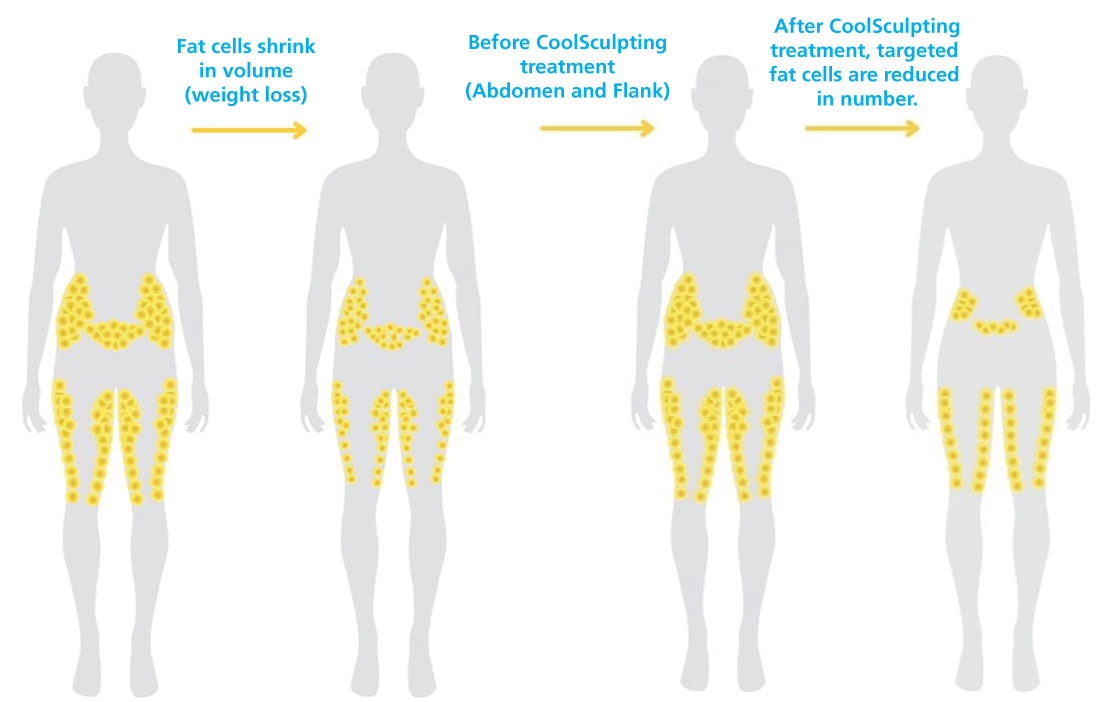CoolSculpting FAQ’s
What is CoolSculpting or the CoolSculpting Procedure?
The CoolSculpting Procedure is a non-invasive way to effectively reduce fat bulges in targeted areas of the body. The CoolSculpting Procedure employs advanced cooling technology that targets and eliminates fat cells. Unlike traditional invasive surgical procedures, the CoolSculpting Procedure is non-invasive, with no needles and no incisions. There is no need for anesthesia or pain medication, and there is no recovery time. The treatment is performed in a medical office under the supervision of a physician.
*Individual results may vary
How does CoolSculpting Procedure work?
During the treatment, a non-invasive applicator delivers precisely controlled cooling to a treatment area. As heat is extracted, the subcutaneous fat is cooled, and fat cell death is triggered. This natural process of removal reduces the thickness of the fat layer. The result is a reduction that is visible within two to four months in most patients. The process is called Cryolipolysis.
 What clinical evidence shows that CoolSculpting Cryolipolysis really works?
What clinical evidence shows that CoolSculpting Cryolipolysis really works?
ZELTIQ™ has performed controlled clinical studies, which show that for properly selected patients, the CoolSculpting Procedure is an effective way to reduce fat bulges. Since CoolSculpting has become commercially available, these results have been repeated with millions of patients worldwide.
*Individual results may vary
How is CoolSculpting different from other fat reduction procedures?
The controlled cooling during a CoolSculpting Procedure treatment targets and eliminates only fat cells. In addition to affecting fat cells, treatment modalities such as lasers, radiofrequency, and focused ultrasound affect other tissues in a way that is not comparable to the ZELTIQ method of Cryolipolysis.
*Individual results may vary
How does Cryolipolysis work?
Cryolipolysis is based on the principle that fat cells are more vulnerable to energy extraction (cooling) than surrounding tissues. A non-invasive applicator is attached to the targeted treatment area to extract energy from the underlying fat tissue, while protecting the skin, nerves, muscles, bones, and other tissue. The cooled fat cells undergo apoptosis (controlled cell death) and are gradually eliminated through the body’s normal metabolic processes, reducing the thickness of the fat layer.
*Individual results may vary
How cold is “cold”?
Lipids in fat cells crystallize at warmer temperatures than other water- containing cells. This is how Cryolipolysis can be selective and target only fat cells for destruction, while sparing other tissue such as skin, muscle, and nerves. The CoolSculpting System controls the rate of energy extraction or cooling during the procedure to achieve consistently optimal results for each individual patient.
What happens to the fat cells?
As heat is extracted from the subcutaneous fat during a CoolSculpting Procedure, the fat cells begin to die via a process called Apoptosis. This natural process of fat cell death and proceeding phagocytosis (lipid removal) gradually reduces the thickness of the fat layer. The dead fat cells in the treated area are eliminated through the body’s normal metabolic processes, similar to how fat from food is eliminated. Fat bulge reduction is visible to most patients in two to four months.
*Individual results may vary
How long do the results last?
The number of fat cells will not increase after they have been removed through CoolSculpting.
*Individual results may vary
How long until I notice results?
In properly selected patients, the CoolSculpting Procedure results in a noticeable, measurable reduction in fat bulges in two to four months. Some patients have appreciated changes beginning as early as 3 weeks after a procedure.
*Individual results may vary
How long does the procedure take?
Procedure time can be one to three hours depending on the number of areas to be treated. During your consultation, your doctor will discuss how long your procedure will take and how much time you should allow for your office visit.
Will I benefit from additional CoolSculpting procedures?
A follow-up visit should be scheduled with your doctor two to four months after your procedure to assess your results. At this time additional CoolSculpting Procedures will be considered to achieve further fat reduction.
*Individual results may vary
Am I a good candidate for a CoolSculpting Procedure?
Ideal candidates for CoolSculpting have some modest-size fat bulges that are not easily reduced through diet and exercise. They are seeking reduction for specific areas of fat, but are not considering a surgical procedure. CoolSculpting is not a way to lose weight or treat obesity, and it is not a substitute for invasive methods like liposuction. During a consultation, your doctor will discuss whether you are a good candidate for CoolSculpting.
*Individual results may vary
What are common side effects after the procedure?
The CoolSculpting Procedure is completely noninvasive, which allows immediate return to normal activities such as work or exercise. Redness may appear in the treated area, and may last from a few minutes to a few hours. Some localized bruising may occur, which clears within a few weeks. Many patients experience a temporary dulling of sensation in the treated area lasting one to eight weeks.
*Individual results may vary
Does the CoolSculpting Procedure hurt?
The CoolSculpting Procedure is comfortable for most patients. Typically patients are comfortable enough to read, work on their laptop computers, listen to music, or just relax during the procedure.
*Individual results may vary
Is there downtime after the procedure?
There is no recovery time after the CoolSculpting Procedure. You may resume your normal activities on the same day as your procedure, including work and exercise.
*Individual results may vary
Should I expect bruising?
Bruising is patient specific and normal. It is a consequence of patient selection and is also location specific. We find that some patients bruise more than others and to a varying degree in different locations.
*Individual results may vary
Free Consultation
Let our experienced staff answer all your questions about CoolSculpting.
